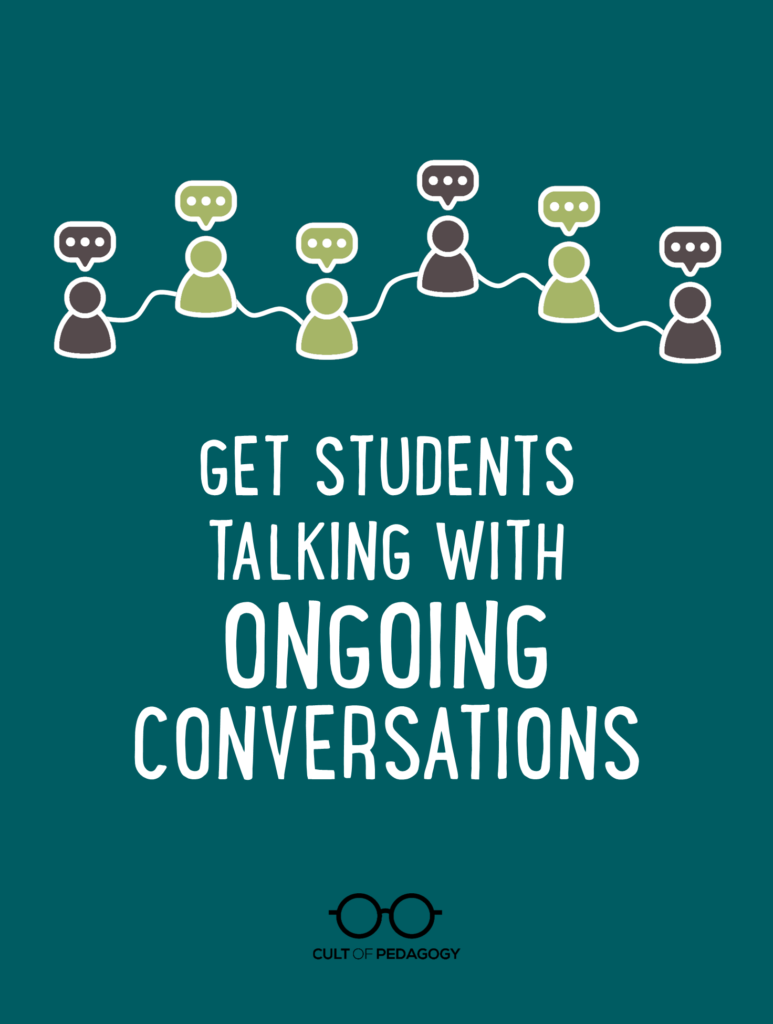
Listen to my interview with Jeff Frieden (transcript):
Sponsored by Peergrade and Microsoft Teams for Education
In our dreamiest of teacher dreams, some of us might imagine days when our students spontaneously erupt into complex, nuanced conversations about the things they’re learning in our classes. If we borrow the language of the Common Core, they would “engage effectively in a range of collaborative discussions (one-on-one, in groups, and teacher-led) with diverse partners on grade-level topics, texts, and issues, building on others’ ideas and expressing their own clearly.”
Sounds wonderful, doesn’t it? And maybe the “teacher-led” kind is possible, because we could structure and guide it, but that doesn’t give students much ownership of their learning. In groups? That might be a bit harder to accomplish. And one-on-one? Well, how do you even manage that?
Jeff Frieden, a high school English teacher in southern California, wondered the same thing. Wanting a less teacher-centered class, he was looking for ways to get students talking to each other about the content. He’d tried all kinds of techniques— think-pair-share, appointment clocks, groups of four—but none of them gave him the results he was looking for.

Jeffery Frieden
When he tried to get the whole class talking in mixer-style activities, they would “poke holes in those systems,” he said. “They just kind of work their way around it to end up talking to their friends, and it becomes more social than content-centered interaction.” Meanwhile, he also discovered that many of his students, who had gone to school together for years, didn’t know each other’s names.
Then one morning, just a few minutes before class started, he came up with something new on the fly: A simple system for getting every student in the room to talk with every other student, a way of tracking conversations over time so that students had a reason to reach out to people they never interacted with, and have more meaningful, content-based discussions with each other. Since he started using this method, Jeff says his classroom just feels different. Students are taking more academic risks, diving deeper into the content, and actually getting to know each other.
The Strategy
Here is the Ongoing Conversations system Frieden uses to get his students talking:
- Each student is given a conversation tracker, a chart where they keep track of the conversations they’ve had with other students in the class.
- Students are to have conversations with a minimum number of other students (set by the teacher—about 75 percent of the class) over a predetermined period of time (say, 2 to 3 weeks). These conversations can be structured, based on topic prompts supplied by the teacher.
- On their tracker, students record the name of the person they talked to, the date of their conversation, and a one-line summary of what they talked about.
- Once a pair of students has had a conversation, they may not return to each other until after they have reached the minimum number of unique conversations set by the teacher.
The image below shows one version of a conversation tracker, where Frieden’s students were discussing a novel they’d read.
Currently, Frieden scaffolds the conversations by supplying topics for each round of conversation; students are not left to come up with ideas on their own. He projects these topics one at a time on Google Slides: “It might be something as simple as, Explain one thing that really confused you from the chapter to your partner.” Sometimes he’ll recycle a topic by having students switch partners, then summarize the conversation they just had with their last partner.
The Benefits
On the first day Frieden tried Ongoing Conversations, “It went surprisingly well,” he says. “I was actually shocked by how well it was going. And it was more content-centered talking, too; it wasn’t just about their social lives. They were really responding to the prompts that I was giving them and talking about the book.”
Now that he’s using the strategy on a regular basis, he’s found that it delivers several benefits:
More Students Engaged
Before switching to this method, Frieden believes far fewer students were actually participating in his class.
“For years, I was seeing what I wanted to see with student interactions,” he says. Although his class discussions felt lively, “I might have like a third of my class really interacting.” Moving to Ongoing Conversations gave more students an opportunity to really participate in discussions.
Simple, Actionable Formative Assessment
When he uses Ongoing Conversations, Frieden says, “My check for understanding is by walking around. The other day my sophomores were talking about Animal Farm, and I had asked a question about Clover, and there were way too many of them saying, ‘Clover? Who’s Clover? I don’t know who Clover is.’ And so I just went, ‘Okay. Time out.’ And then we talked about that character and her relevance in the story.”
As a formative assessment method, Ongoing Conversations offers two advantages: It lets teachers take immediate action—like in the scenario above—and it gives them less work to take home. “I don’t need to do exit tickets, I don’t need to do quizzes,” Frieden says, “I collect less work, but students do more.”
Works with Other Strategies
This method can be blended with other discussion and instructional strategies. For example, if Frieden is having students do a philosophical chairs discussion, he might have them turn and talk with someone on their side of the room, then record that interaction on their conversation tracker.
Not Just for English Class
Ongoing Conversations is a strategy that can be used in any content area. Although Frieden initially structured these conversations around literature, he quickly realized they could be expanded beyond that. When he moved students into an inquiry-based research project, he continued using the conversation tracker, swapping out literature-based questions with prompts that centered on the research students were doing.
Grading and Assessment
Do these conversations get a grade? When Frieden first started using this system, he gave students a small amount of points for these conversations, and that would work in a points-based classroom. This year, however, he’s been working toward a modified version of a gradeless classroom, where a student’s course grade is determined by a conference in which the student must justify how well they’ve met the standards.
Frieden has found that knowing these conferences are coming is what generally keeps students motivated to give the Ongoing Conversations a good effort; they know Frieden is paying attention. “I’m watching,” he says. “I’m going to hold you accountable to this, and eventually we’re going to have a conversation. You’re going to have to look me in the eye and say, ‘This is what grade I deserve,’ or ‘Here, I can justify this grade.’”
Tips for Success
Don’t “Free-Range” It
Frieden did not just hand students the charts and tell them to start talking: Even though they are in 12th grade, they needed a bit of structure for the strategy to be successful; younger students would need even more scaffolding. In addition to providing questions for discussion, talk with students ahead of time about behavior expectations, how to initiate conversations, how to ask follow-up questions, and even how to record the content on the tracker. You might even want to model a conversation fishbowl-style, with you as one of the participants, so students can see what a good quality conversation looks like ahead of time.
Frame the Discussion Through a Helping Lens
To relieve the anxiety students might feel about these conversations, Frieden launches the conversations by framing them through a lens of mutual support.
“I’m going to come clean that I’m a confused reader,” he tells them. “Join the club. When I read something for the first time, it’s always confusing, and I need help to understand it. So let’s basically form this class-wide support group here for struggling readers, and as we go through this, let’s talk about the things that are perplexing to us that we don’t get, words we don’t understand. Maybe we miss a detail that our partners or our friends figure out, so they can help us.”
Setting this tone has helped student relax. “They kind of know, ‘Oh, okay. We’re just in here to kind of feel our way through this novel,'” Frieden says. “That’s what I’m hoping.”
The Value of Conversation
Giving students regular opportunities to engage in rich conversations is good for them in so many ways. “There’s tremendous benefit in getting past some of the socially awkward stuff,” Frieden points out. “And really just learning how to interact with another human being will actually enrich your academic life too.”
Students are recognizing the benefits, too. “Even though they’re struggling through the discomfort, they say that it’s exposing them to ideas they wouldn’t have considered had they just been asked to do it alone or respond on a worksheet,” Frieden says. “I had one student who actually wrote a lengthy response saying, You know what? I don’t know if I’ve changed my mind, but I just told myself, ‘For the sake of this, I’m going to be open,’ and it’s actually changed the way I think about this issue.”
It was one of those rare moments when you know you’re doing something right.
“My teacher nerd heart was singing that day.” ♥
You can learn more from Jeff Frieden by following him on Twitter or visiting his website, Make them Master It, where he shares tons of great ideas and insights about teaching. You can read his original post about Ongoing Conversations here.
Join my mailing list and get weekly tips, tools, and inspiration that will make your teaching more effective and fun. You’ll get access to our members-only library of free downloads, including 20 Ways to Cut Your Grading Time in Half, the e-booklet that has helped thousands of teachers save time on grading. Over 50,000 teachers have already joined—come on in.





Brilliant podcast. Thank you both for sharing such a meaningful strategy for supporting student conversations. Can’t wait to give it a go.
Thank you! When you do, please let me know how it goes!
Glad you enjoyed the post, Tina! Have fun!!!
Jeffrey,
Thank you for this! I love anything which makes the trade of compliance-work for students and for content-learning through life experience. And this is beautifully simple for all grades and subjects!
Yes, students need to regularly practice discussions, to know how to get to know another human being, to see all people as people who can help teach us something.
This method is a gem! Thank you for sharing! I’ll be using it often!
Thanks to you, too, Jennifer, for helping to bring it to so many teachers for so many students!
All the best,
Marisa
We’re going to have to talk through a mash up of TQE Method and Ongoing Conversations! Either start with Ongoing Conversations to tease out the TQEs before the big class-wide discussion, or the small group > TQE revisions > class-wide discussion is a way for the group to practice before they take the TQE’s to one-on-one discussions.
Hmmmmmmm….
Hi there. Thanks for this. I will definitely use it. I have a clarifying question. What is TQE? Is it similar to DBQ (Data Based Questioning) or QFT (Question Focus Technique)?
Thanks again,
Kathe
Hi Kathe,
English teacher, Marisa Thompson, discusses her approach to teaching text in the post Deeper Class Discussions with the TQE Method. TQE (thoughts, questions, epiphanies) is similar to a socratic seminar, but with a few twists — check it out!
First of all, I really like how Jeff didn’t adjust his expectations and hopes for genuine content conversation in his room, as many of us may be tempted to do. He kept going until he found something that actually got his students to engage the way he wanted to.
The strategy he came up with seems both simple and brilliant. In addition to reaching his goals with this strategy, the concept of summarizing a conversation is a skill needed in the business world. I am currently a student teacher in the midst of a career switch. I was previously at an office job, and I remember finding it surprising and somewhat irritating when my boss told me I needed to draft a recap email following a meeting with a client. Additionally, it was surprisingly challenging: what exactly did we decide upon again? What were the main takeaways? I wish I took better notes! I think summarizing a discussion is more complicated — and perhaps more useful — than summarizing text, which is something we have our students do all the time.
I hope I can launch this Ongoing Conversation strategy in my placement or at my first real teaching job. I can see how this would be easily adapted to a social studies classroom, and could even maybe be used as a “warm-up” where students start class discussing current events.
Taylor, thank you for the encouraging words! I am delighted to hear that this could be something you use as you enter the classroom. When I first entered the profession, I taught the way I was taught. The way I was taught worked okay for me, but it wasn’t resonating with my students, and it didn’t fit the needs they had. So, good for you to break out of the mold set for you (assuming you didn’t have strategies like this when you were in school). And, yes, it was challenging to keep going with strategies that didn’t quite fit what I was looking for while not giving into defeat (“I guess kids these days, can’t do this kind of thing”). But I have thought my way around a few problems as a teacher. In some cases, it’s just a matter of persistence over time.
What you said about the connection with the business world squares up with one listener who is a C-level Executive Assistant for a fairly big firm in the Silicon Valley (apparently the audience of this podcast expands beyond the public education sector). She tells me that this is sorely lacking in the business world. The way she describes it, the work environment sounds like too many classrooms where people sit alongside one another, don’t interact, and quietly work on their tasks. They even put their earbuds in and tap away on their keyboards!
I have had enough of that in my classroom (where I have a laptop cart). We use tech, we have times of sitting quietly (during Sacred Silent Reading time), but my students are encouraged to process their uncertainty together, to discuss, to interact around content, and even argue amicably with one another after they have built up some knowledge on a topic. More than learning ELA content, I want my students to be fully functional, fully mature members of our society. That won’t all happen in my classroom, but I can help play my part to its fullest. The way Dave Stuart Jr. puts it resonates with me, “for the long-term flourishing of students.” It’s not enough for me that my students learn the content. I expose them to more in the hopes that they will be well-rounded individuals who make a positive contribution and add value to their communities when they leave my classroom.
Thanks for commenting and for the encouraging thoughts!
Thank you so much for sharing this awesome strategy! I’m also a high school ELA teacher and this is GOLD! I can’t wait to try it with my classes.
Dana,
So glad you enjoyed the post! If you get a chance, let us know how it goes!!!
It has been a game changer, for sure! Please connect with me about how it goes in your classroom. I want to hear all about it!
I can’t wait to start this strategy! Thanks for sharing!
How long do students stay in their conversations? (I realize it may depend upon the question.) Do students determine when the conversation has ended? Or, do you try to get them to stay in conversation for a certain length of time?
It does depend on the complexity of the question. If I’m not sure, I will ask for more time than I think they need, then when they are in a lull, I will move them along.
But sometimes I use a good old fashioned worksheet, and have people partner up for one section, set a timer, and then walk around to listen to the conversations.
Recently, I have used it for close reading strategies, having the student collaborate on text chunking for a decriptive outline. Really, the applications are endless. Just find a opic or a task you want them to engage with, break it down into it’s parts, and then get them talking.
This is one of my favorite podcast episodes. It is a very practical idea that can be used in any classroom. I am thinking of trying this in my middle school science class. How do students know when a conversation is over? Is there a time limit? (I’m not sure if this was clarified in the podcast) Thank you
Oh no! It was one of the logistics missing in the interview!
Simple. Use Google Slides, click “insert” in the top menu, click “video” > search you tube for the desired timer (I usually search “4 minute timer”) > adjust the size of the video to fit your needs on the slide (I leave enough room for a prompt/question and the video countdown. I like the bomb with the fuse. That’s my favorite).
I am in favor of all ideas that address the #1 language art, speaking. Jeff’s commitment to helping students develop as speakers and listeners is a huge gift to those kids.
Aww, thanks Erik! My students wouldn’t be where they are without your important work. Thanks for simplifying instruction for the # 1 language art too!
Everyone should pick up a copy of Well Spoken at any grade level, teaching any content area. It’s the best!
This is a brilliant idea… the missing piece!!!! Students as active participants of their learning rather than passive spectators. Thank you Jennifer and Jeffrey for sharing!!
So glad you enjoyed this, Ana!
The missing piece, yes! It has helped to improve all the other types of discourse and activities I use in my classroom to get students talking.
A big thank you to Jeffrey and Jennifer for introducing this technique with students. I agree with what Eric Palmer mentioned in his feedback. I am also supportive of the accountability factor that Jeffrey has established when the student has to justify the grade or points earned from the activity. Students can be reminded that the teacher is “watching” and following up with a conversation that they will need to be engaged in with the teacher. I loved this podcast. It is something I will put into action to a higher frequency. Thanks again for sharing this discussion-based model and calling it Ongoing Conversations.
Thanks, Arjan! The best part about the summary piece is how it helps the students with recall later, which is so much more important than accountability (but it can help with accountability too). When they can retrieve their most surprising insights, or counterclaims to their stance, that’s where the power of the activity really is. To be able to retain and analyze a chain of thought over an extended period of time is one of the best practices I can give to my students.
I enjoyed this so very much! I am trying this strategy out in my 7th grade history class starting today. I have modified it to fit my students and teaching style, and cannot wait to see the results! I too have a group of students that don’t know each other’s names, and refuse to step outside of their bubble to talk to people that are not their friends. Our district is focusing on speaking and listening standards this year, so this came at the perfect time. Thank you so much for all of your resources!
So glad to hear this, Shania!!!
Two thoughts! The great part about this activity is the potential for it to meet many standards all at once. They are speaking and listening, yes. But depending on the topic, they may also be applying several other literacy standards simultaneously, like citing textual evidence. Since I am less familiar with social science, I imagine you may be working with your own set of standards or a framework. That means you could also be asking them to apply standards from that framework as well. There are so many layers!
As for your students’ level of comfort in interacting with one another, do what you can to instruct how they initiate and close a conversation. This generation has grown up with screens everywhere, and they are not totally sure how this human interaction thing works. And some times its risky, causing a lot of anxiety. But if we gently coach them, they can rise to the occasion. They really need our help!
Jeff,
I just engaged the 9th-grade students in a Novel Chat today. They’re reading Anthem, so we had chats with three different people based on the first half of the novel and a few double-entry journals they’d completed. My students already have a lot of practice with discussions and community norms regarding discussions as we engage in weekly Touchstones Discussions (www.touchstones.org (I’ve mentioned them before)).
So happy to have found this method and make your acquaintance. I’ve pushed my classroom towards more voice and choice for the past decade. It’s a slow process, and I still find myself uncomfortable at times, but this method was a no-brainer. The summary box holds them accountable, provides an artifact for the ephemera of the discussion, and allows them to use these discussions for future writing or revision of their own views.
Also, as a former speech and debate coach for 25 years, I agree with Erik Palmer that this puts the #1 skill at the fore. And it gives them such great practice with listening as well.
Thanks, Garreth! I appreciate the support!
Hi Jeff!
Wow! Creating student-centered learning and dialogue conversation has been an ongoing discussion within my teacher education program and a continued challenge for me within my student teaching classrooms. I found very similar things to you- whether that was limited engagement or some students slipping through the class, I certainly wasn’t reaching everyone. While articulating these expectations may help, I love your idea to create a structure that truly facilitates this shift! Not only does this encourage student to stay on content-based topics, but this method also helps to have students talk to people outside of their social groups! I am thrilled to hear that you’ve felt a shift in the student atmosphere, and that you’ve been able to use this as a formative check for understanding as well. I will absolutely implement this within my future classroom next semester! I’m so curious to hear as well how your shift to a gradeless classroom has been!! What have you noticed in terms of student work and motivation? How has this been in terms of time management for you as you give feedback? Thank you for this thought provoking piece and for your actionable strategies! I can’t wait to try this out soon 🙂
Emily,
I appreciate your characterization of Ongoing Conversations, especially the words “structured” and “actionable.”
Giving feedback can be time consuming, but without worrying about points, I have been energized by the process. When I was using points on assignments, I was trying to justify why students didn’t earn more points, which meant my feedback focused on what students were doing wrong. This was draining psychologically because it made me focus on all the students were getting wrong instead of highlighting what they were doing well and pointing them toward next steps.
If you follow my blog (makethemmasterit.com), I plan to post my insights there. But if you’re looking for immediate results into your inquiry about a gradeless classroom, check out teachersgoinggradeless.com/ (also @TG2chat on Twitter and the Teachers Going Gradeless Facebook group).
I started using this about a week after listening to the podcast. I use it in my 6th, 7th, and 8th grade Health classes. It really is a game changer. I apply an ongoing conversation to most of the topics I cover and it is generally successful. Question: Do you think it can be over used? I’m starting to notice some students avoiding finding a new partner and some resisting participating. That being said, overall I’m getting a good amount of participation and when I circulate around the class I’m hearing some real conversations.
One more question: Do you incorporate a whole class discussion after an ongoing conversation? After they return to their seats I frequently ask for volunteers to share parts of their conversation and wondered if others build this in or not.
Jenn-G-W,
To both of your questions, YES!
Diminishing returns, too much of a good thing, are just part of the way our brains work. Brains also like novelty, so if we keep repeating a task over and over, even one we like, we grow bored. This is normal. For me, I try to go through only 6 rounds of it all year.
And to answer your 2nd question, I absolutely would break it up with class discussion. During the episode, I briefly described how I would “interrupt” Ongoing Conversations with a Four Corners discussion, where we would move the discourse from inquiry-based to argumentative. Disrupting the flow of the Ongoing Conversations activity with other types of discussion models is also a great way to bring in that novelty that will freshen up Ongoing Conversations after your students are getting the hang of it.
Here are some discussion models to try out:
* Socratic Seminar (Circles, Pilot Co-Pilot)
* Four Corners
* Philosophical Chairs
* Pop Up Debate (https://davestuartjr.com/pop-up-debate/)
I hope this helps!
Hey Jenn,
In addition to the list of strategies Jeffrey mentioned, check out Jenn’s post, The Big List of Discussion Strategies, for other discussion models you can mix in with ongoing conversations.
I’ve used this method a couple of times in both ELL and English classes for a variety of reasons. I found it was AMAZING in my ELL class where I gave each student a different question about the content and had them write their answer. Then they got to practice asking their question as well as having to answer another persons. Students who had never spoken before were talking!
Interestingly, I used it today in my English 9 enriched class and it was a lot less successful. Students did not want to move and I had to facilitate a lot more groups.
Michelle,
I am so glad to hear about the success in your ELL class! That’s very encouraging!
I am bummed that it’s not met with the same willingness in your 9th grade students (is ‘enriched’ like ‘honors?’). In the podcast episode I discussed that it was a class of 11th graders who were reluctant to talk with one another that led me to create the Ongoing Conversations Tracker, which helped me to get the students moving. My students struggled too. I had to do quite a bit of coaching and cajoling, even getting students to move at random (for instance, they could look at the roster I created for the class, and I could say to the class, “If you’re an even number, then you have to move”).
If you are looking to make it a success with your English 9 class, then feel free to reach out to me by email (makethemmasterit@gmail.com) or you can find me on Twitter @MakeThemMastrIt. I would be happy to help you, or anyone, to think it through.
This has given me a new perspective on ongoing conversations. I am very interested in the students creating their own prompts.
I just took a tech course and found out about Parlay. With the in certainty of in class teaching, this platform might be a wonderful option to keep the conversations flowing. They do online and live round table discussions that also track and provide data. Thoughts on this tool? Would it still work ?
Thanks for this wonderful information.
Angela, I’ve not personally used Parlay, but I’d give it a try and see what happens. It seems like it could work really well!
I love this strategy so much! I do notice with my largest, most self-conscious class that there’s a level of social anxiety associated with the “find a new partner” phase… previously this wasn’t challenging until they’d met with 60% of the class or so, but I can feel the students’ dread at being the “student who couldn’t find a partner” each time we switch. Has anyone ever found an app or designed an algorithm to randomly group a list of names into pairs, with each round creating original, non-duplicating pairs?